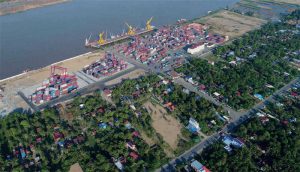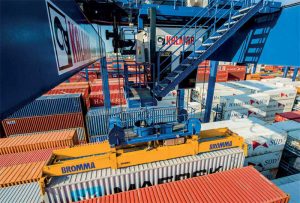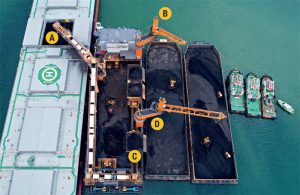Asia is an economy in expansion. Julian Champkin investigates the lifting market there.
- Kalmar cranes in action in Vietnam
- Kalmar’s fully electric, zero-emission RTGs are being used at the Tan Cang–Phu Huu terminal in Vietna
- Liebherr dock cranes can also be mounted on floating pontoons, as here at Kalimantan, Indonesia. The
In December 2020 China overtook the US to become the EU’s largest trading partner. (Source: Eurostat). In part that was due to China’s faster recovery from the Covid pandemic, but only in part. Asia is a growth market, and a growth area of production also: the term ‘tiger economy’ is still very far from irrelevant. Sany is a company that could be said to epitomise the size, opportunity and growth of the market in China—and to epitomise also the drive for overseas markets, embodied in the ‘belt and road’ initiative introduced by central government in 2013.
One of the most successful of China’s manufacturers, Sany produces heavy construction and industrial equipment, targeting the higher-quality end of the market. One of its specialisms is port lifting gear: gantry cranes, RTGs and RMGs, as well as empty container handlers. Louis Chan is sales and marketing manager for Sany port machinery.
“We serve primarily three kinds of customer,” he says. “Firstly, the stateowned terminals and yards, such as Shanghai and Qingdao.” It is well to keep in mind here the scale of China’s markets. Shanghai is the world’s busiest containerport; Qingdao is one of the ten busiest ports in the world. “Secondly, there are the port operators, such as Hutchinson, PSA and Maersk.” Singapore-based PSA operates ports as far apart as Antwerp, Halifax and Singapore itself. “A third market that is just opening up in China is the inter-modal, of transferring containers and goods between sea or riverport and rail or road. This has been a major sector in Europe for some years but in China it is a recent development, and an emerging one as the nation is engaged in expanding its rail transport system. As well as those three, a smaller amount of our business is to the private sector, where we have around one-quarter of the market share.”
Demand from customers, he says, is for two innovations in particular. “The first is for automation. Ports are very labourintensive, especially for port operators, and manpower costs money, in China as in the rest of the world. Nowadays all terminals and operators are hoping to reduce that expenditure, so automation is a trend.
“The second demand is for electrification and the move from diesel power. So we produce electric gantry cranes, and also electric reach-stackers. Our latest product in this sector addresses both those demands, for automation and for electric power. The ARTG, or automated rubber-tyred gantry crane, is a first in the sector. Our first blockorder was to the China Merchants port in Shenzhen, Guangdong province. The port is modernising and expanding, and we delivered 27 of this new product to them in October 2020.
“Similarly, we are providing ten electric powered empty container handlers for Singapore port. That, too, is the first batch of this product in the industry.
“The classic markets for Chinese manufacturing are South-east Asia and Africa; in the port machinery sector, that is true but only half of the truth. We are also very active in the USA. 20% of our port machinery sales are there; next year we hope to increase that to 30%. We have a very good portfolio which should help towards that target.” COSCO, the China state shipping line, is investing in ports in the Middle East, in UAE and Abu Dhabi, again as part of the belt and road policy.
“We have supplied mobile port equipment for those projects; we have not sent them gantry cranes yet but that may come.” China of course was the first county to be hit by the Covid-19. It also took strong and effective counter-measures early; so although companies took a hit around mid-year 2019 much of its economy is now back to near normal—and where many Western companies have struggled, some Chinese ones have had a remarkably good year. Sany is one of them.
Chinese crane companies are becoming the world’s most important crane manufacturer



没有评论:
发表评论